U.S. Department of Transportation
Federal Highway Administration
1200 New Jersey Avenue, SE
Washington, DC 20590
202-366-4000

FHWA/US DOT (HPIP)
400 Seventh Street, SW
Washington, DC 20590
Tel: 202-366-9636
Fax: 202-366-9626
international@fhwa.dot.gov
international.fhwa.dot.gov
HPIP/08-02(7M)EW
Publication No. FHWA-PL-02-011
The contents of this report reflect the views
of the authors, who are responsible for the facts
and accuracy of the data presented herein. The contents do not
necessarily reflect the official
policy of the Department of Transportation.
The metric units reported are those used in common
practice by the persons interviewed.
They have not been converted to pure SI units because in some
cases, the level of precision
implied would have been changed.
The United States Government does not endorse
products or manufacturers. Trademarks or
manufacturers' names appear herein only because they are
considered essential to the
document.
The publication of this document was sponsored
by the U.S. Federal Highway Administration
under contract number DTFH61-99-C00005. awarded to American
Trade Initiatives, Inc. Any
opinions, options, findings, conclusions, or recommendations
expressed herein are those of
the authors and do not necessarily reflect those of the U.S.
Government, the authors' parent
institutions, or American Trade Initiatives, Inc.
This report does not constitute a standard, specification, or regulation.
| Technical Report Documentation Page | |||
| 1. Report No. FHWA-PL-02-011 |
2.Government Accession No. | 3.Recipient's Catalog No. | |
| 4. Title and Subtitle Wildlife Habitat Connectivity Across European Highways |
5.Report Date August 2002 |
||
| 6. Performing Organization Code | |||
| 7. Author(s) Fred G. Bank, C. Leroy Irwin, Gary L. Evink, Mary E. Gray, Susan Hagood, John R. Kinar, Alex Levy, Dale Paulson, Bill Ruediger, Raymond M. Sauvajot, David J. Scott, Patricia White |
8.Performing Organization Report No. | ||
| 9. Performing Organization Name
and Address American Trade Initiatives P.O. Box 8228 Alexandria, VA 22306-8228 |
10. Work Unit No.(TRAIS) | ||
| 11. Contract or Grant No. DTFH61-99-C-0005 |
|||
| 12. Sponsoring Agency Name and
Address Office of International Programs Office of Policy Federal Highway Administration U.S. Department of Transportation |
13. Type of Report and Period Covered | ||
| 14. Sponsoring Agency Code | |||
| 15. Supplementary Notes FHWA COTR: Donald W. Symmes, Office of International Programs |
|||
|
16. Abstract As a result of the trip, the team formed conclusions and recommendations for U.S. applications in the areas of policy, communications, guidance manuals, and research. In particular, the group recommends (1) including wildlife/transportation issues in the FHWA and AASHTO strategic plans; (2) creating a central source of contact for international exchange of information; (3) developing a number of guidance manuals pertaining to assessment methodologies, interagency coordination, terminology, and structures design; and (4) using pooled funds to study connectivity needs for all types of wildlife; and (5) funding a national connectivity study. |
|||
|
17. Key Words
|
18. Distribution Statement No restrictions. This document is available to the public from the Office of International Programs international@fhwa.dot.gov www.international.fhwa.dot.gov |
||
| 19. Security Classif. (of this report) Unclassified |
20.Security Classif. (of this page) Unclassified |
21. No. of Pages 48 |
22. Price |
Form DOT F 1700.7 (8-72)
Reproduction of completed page authorized
|
Fred G. Bank C. Leroy Irwin Gary L. Evink Mary E. Gray
|
Susan Hagood John R. Kinar Alex Levy Dale Paulson and American Trade Initiatives, Inc. & Avalon Integrated Services, Inc.
|
Bill Ruediger Raymond M. Sauvajot David J. Scott Patricia White |
for theFederal Highway Administration
|
||
The FHWA's international programs focus on meeting the growing demands of its partners at the Federal, State, and local levels for access to information on state-of-the-art technology and the best practices used worldwide. While the FHWA is considered a world leader in highway transportation, the domestic highway community is very interested in the advanced technologies being developed by other countries, as well as innovative organizational and financing techniques used by the FHWA's international counterparts.
INTERNATIONAL TECHNOLOGY SCANNING PROGRAM
The International Technology Scanning Program accesses and evaluates foreign technologies and innovations that could significantly benefit U.S. highway transportation systems. Access to foreign innovations is strengthened by U.S. participation in the technical committees of international highway organizations and through bilateral technical exchange agreements with selected nations. The program has undertaken cooperatives with the American Association of State Highway Transportation Officials and its Select Committee on International Activities, and the Transportation Research Board's National Highway Research Cooperative Program (Panel 20-36), the private sector, and academia.
Priority topic areas are jointly determined by the FHWA and its partners. Teams of specialists in the specific areas of expertise being investigated are formed and sent to countries where significant advances and innovations have been made in technology, management practices, organizational structure, program delivery, and financing. Teams usually include Federal and State highway officials, private sector and industry association representatives, as well as members of the academic community.
The FHWA has organized more than 50 of these reviews and disseminated results nationwide. Topics have encompassed pavements, bridge construction and maintenance, contracting, intermodal transport, organizational management, winter road maintenance, safety, intelligent transportation systems, planning, and policy. Findings are recommended for follow-up with further research and pilot or demonstration projects to verify adaptability to the United States. Information about the scan findings and results of pilot programs are then disseminated nationally to State and local highway transportation officials and the private sector for implementation.
This program has resulted in significant improvements and savings in road program technologies and practices throughout the United States, particularly in the areas of structures, pavements, safety, and winter road maintenance. Joint research and technology-sharing projects have also been launched with international counterparts, further conserving resources and advancing the state of the art.
For a complete list of International Technology Scanning topics, and to order free copies of the reports, please see list on the facing page.
Website: www.international.fhwa.dot.gov
Email: international@fhwa.dot.gov
International TechnologyScanning Program: Bringing Global Innovations to U.S. Highways
Geotechnical Engineering Practices in Canada and Europe
Geotechnology-Soil Nailing
International Contract Administration Techniques for Quality
Enhancement-CATQEST
European Asphalt Technology
European Concrete Technology
South African Pavement Technology
Highway/Commercial Vehicle Interaction
Recycled Materials in European Highway Environments
European Bridge Structures
Asian Bridge Structures
Bridge Maintenance Coatings
European Practices for Bridge Scour and Stream Instability Countermeasures
Advanced Composites in Bridges in Europe and Japan
Steel Bridge Fabrication Technologies in Europe and Japan
Performance of Concrete Segmental and Cable-Stayed Bridges in
Europe
Sustainable Transportation Practices in Europe
Wildlife Habitat Connectivity Across European Highways
European Right-of-Way and Utilities Best Practices
European Intermodal Programs: Planning, Policy and Technology
National Travel Surveys
Recycled Materials in European Highway Environments
Geometric Design Practices for European Roads
Pedestrian and Bicycle Safety in England, Germany and the
Netherlands
Speed Management and Enforcement Technology: Europe & Australia
Safety Management Practices in Japan, Australia, and New Zealand
Road Safety Audits-Final Report
Road Safety Audits-Case Studies
Innovative Traffic Control Technology & Practice in Europe
Commercial Vehicle Safety Technology & Practice in Europe
Methods and Procedures to Reduce Motorist Delays in European
Work Zones
Freight Transportation: The European Market
Advanced Transportation Technology
European Traffic Monitoring
Traffic Management and Traveler Information Systems
European Winter Service Technology
Snowbreak Forest Book - Highway Snowstorm Countermeasure
Manual (Translated from Japanese)
European Road Lighting Technologies
Emerging Models for Delivering Transportation Programs and
Services
Acquiring Highway Transportation Information from Abroad-Handbook
Acquiring Highway Transportation Information from Abroad-Final
Report
International Guide to Highway Transportation Information
All publications are available on the internet at www.international.fhwa.dot.gov
CONTENTS |
|
|---|---|
| EXECUTIVE SUMMARY | vii |
| CHAPTER 1: INTRODUCTION | 1 |
| Objectives and Panel Composition | 2 |
| Amplifying Questions | 2 |
| CHAPTER 2: EUROPEAN CONTEXT | 3 |
| Regulatory Context | 3 |
| Biogeographical Context | 4 |
| Social Context | 4 |
| Traffic Safety Context | 5 |
| Economic Context | 5 |
| CHAPTER 3: HABITAT LOSS, FRAGMENTATION, AND WILDLIFE MORTALITY | 6 |
| Habitat Loss | 6 |
| Fragmentation | 6 |
| Wildlife Mortality | 6 |
| Secondary and Cumulative Effects | 7 |
| Avoidance and Minimization | 7 |
| CHAPTER 4: ANALYTICAL TECHNIQUES | 8 |
| Planning Techniques | 8 |
| Study Techniques | 9 |
| Analytical Models | 11 |
| CHAPTER 5: MITIGATION AND COMPENSATION | 12 |
| Nonstructural Approaches | 12 |
| Structural Approaches | 14 |
| Maintenance Aspects | 24 |
| CONCLUSIONS AND RECOMMENDATIONS | 26 |
| Policy | 26 |
| Communication Strategy | 27 |
| Guidance Manuals | 28 |
| Research Strategy | 29 |
| IMPLEMENTATION PLAN | 30 |
| Implemention Recommendations | 30 |
| Evaluating or Demonstrating the Potential Scan Results | 31 |
| Disseminating the Scan Results | 31 |
| REFERENCES | 33 |
| APPENDIX A: EUROPEAN CONTACTS | 34 |
| APPENDIX B: TEAM CONTACTS | 39 |
| APPENDIX C: AMPLIFYING QUESTIONS | 41 |
| APPENDIX D: BIOGRAPHICAL SKETCHES | 45 |
ABBREVIATIONS AND ACRONYMS |
|
| AASHTO | American Association of State Highway and Transportation Officials |
| ADT | Average daily traffic |
| CTE | Center for Transportation and the Environment |
| DOT | Department of transportation |
| EC | European Council |
| EEC | European Economic Community |
| EIA | Environmental impact assessment |
| ESA | Ecological Society of America |
| EU | European Union |
| FHWA | Federal Highway Administration |
| GIS | Geographic information system |
| IENE | Infra Eco Network Europe |
| NGO | Nongovernmental organization |
| SAC | Special areas of conservation |
| SEA | Strategic environmental assessment |
| SPA | Special protection areas |
| NCHRP | National Cooperative Highway Research Program |
| NEPA | National Environmental Policy Act |
| NHI | National Highway Institute |
| TEA-21 | Transportation Equity Act for the 21st Century |
| TRB | Transportation Research Board |
With growth and development in many areas of the world, habitat and wildlife resources have diminished to the point that transportation agencies are being asked to address impacts to these resources when implementing planned improvements to the world's transportation systems. The issues involved in addressing these impacts are international in nature. Therefore, the Federal Highway Administration (FHWA) and American Association of State Highway and Transportation Officials (AASHTO) sponsored an international technology scan to learn what actions are being taken in Europe to address habitat and wildlife issues. An interdisciplinary delegation of federal, State, and conservation-group representatives visited five countries to observe and document efforts in Europe. The group visited Slovenia, Switzerland, Germany, France, and the Netherlands.
Overall, the five European countries had much to offer as related to the objectives of the visits. Although each country uses different approaches to address wildlife issues, they have formed an international network to share information. The Infra Eco Network Europe (IENE) is designed to bring together state-of-the-art information through an international project known as "Habitat Fragmentation Due to Transportation Infrastructure." The project is leading Europeans to a more comprehensive treatment of habitat-related issues, and the results ultimately will benefit all of Europe and the rest of the world. This report summarizes the scan team findings, by country, and concludes with detailed recommendations for possible U.S. implementation.
Slovenia is a young country, as is reflected in the number and type of actions that the country has been able to undertake with regard to habitat fragmentation and transportation issues. Although the Slovenians have the necessary environmental documentation processes and environmental laws to address wildlife issues in transportation processes, some inconsistencies remain. One apparent inconsistency observed in Slovenia was that the Eurasian brown bear is both a protected and a legally hunted species. This unique situation has led to interesting perspectives when addressing potential impacts to the species from transportation infrastructure. The delegation observed efforts by parties outside the transportation ministry to bring about project designs to accommodate wildlife. A survey that indicated the public's desire to accommodate habitat and wildlife considerations also was used to influence transportation agency actions.
Slovenia is attempting to increase wildlife habitat (forests) and wildlife populations, including bears and wolves. Slovenia has the opportunity to significantly accommodate wildlife, with international connectivity implications. Connectivity to the forests of Croatia and Italy exists, and there is the potential for further improvements. As was the case in several of the European countries visited, hunting is an important factor in wildlife management, and hunter information is extensively used when examining connectivity needs.
Specifically in Slovenia, university and forestry personnel studied habitat connectivity needs and wildlife behavior (the Eurasian brown bear in particular), and then used public opinion to influence the transportation ministry to provide
EXECUTIVE SUMMARY
connectivity across highways. They also provided the transportation agency with identified connectivity needs and further recommendations for the nation's highways. A public demonstration was held to express the need for action for wildlife on a highway project. The result was a viaduct that was constructed for multiple purposes-wildlife, hydrology, and human access. Subsequent studies of the structure have indicated that a variety of wildlife cross under the structure. Fencing, including electrical fence, is used on Slovenian highways to keep wildlife off of the highways, thereby increasing motorists' safety. The scan team believes that the situation in Slovenia is similar to that in the United States. In the United States, the impact of transportation on wildlife is an emerging issue, and it often takes diverse interests joining together to influence actions on the part of the State transportation agencies, through active public-involvement programs.
In contrast to Slovenia, Switzerland has a long history of science and actions related to wildlife in its transportation and environmental programs. It is evident that the Swiss actions are scientifically based. Geographic information system (GIS)-based identification of wildlife habitat and corridors has been completed, and, again, hunter information is used to supplement science. Bottlenecks and voids in connectivity have been identified. The remaining corridors have been categorized as impacted, impaired, or interrupted, with only one-third categorized as intact. The main corridors are forested, as riparian corridors are highly impacted throughout much of Europe. The scan team observed attempts at riparian restoration. Landscape planning plays an important role in Switzerland, and both habitat restoration and purchase for connectivity are being undertaken.
Expert groups use scientific research to develop standards for assessment, design, and mitigation. Scientific information from other European countries is extensively used in this process, including investigations of other countries' green bridges. Diverse habitats on green bridges were scientifically identified as important to providing connectivity for the broadest spectrum of species, from invertebrates to ungulates. Considerations in vegetation selected even included avian and tree-dwelling species. For example, research documented the relationship of a highway to badgers and the connectivity absent or present for badgers with the placement of crossing structures.
The Swiss have a wide variety of structural and nonstructural measures for wildlife. Overpasses (green bridges or ecoducts) of varying widths are a preferred structure for maintaining connectivity for many species. There is a prevalence of multiple-use overpasses with forestry roads and vegetation on the structures. These structures are monitored using standard approaches such as tracks and photography, as well as evolving technologies such as infrared video. Video cameras make it possible to observe the behavior of the animals while using the structures. This research indicates that overpasses with a width of 50 m or greater are used by the widest variety of species, and that the animals exhibit natural behavioral characteristics when using the structures.
EXECUTIVE SUMMARY
German actions regarding wildlife are legally and scientifically driven. Germany has strong legal requirements, which primarily address motorist safety. Projects are identified at the federal cabinet and parliament levels and then are provided to the transportation ministry for implementation. The Federal Environment Ministry (BMU) is consulted and enforces environmental actions in accordance with the Nature Conservation Act, a Red List (threatened and endangered species), and the Endangered Conservation Act. These actions are supported by the legal act of conservation, including regulations for using land in a sustainable manner. Germany has an early warning system of environmental risk assessment to help avoid environmentally sensitive projects. Landscape planning plays an important role in the identification of protected areas, protection of flora and fauna, and the general protection and mitigation of impacts to the natural environment. Negative changes to land use require compensation measures. The legal foundation is built upon the mitigation of impacts, which is one important regulation contained in the legal act of conservation. Considerable and sustainable impacts on nature balance and natural scenery caused by projects (i.e., motorways) have legal consequences. Two perspectives, home protection and nature preservation, influence the process. Project managers are obliged to take measures in the case of considerable and sustainable impacts. Three kinds of compensation are possible: in-kind, off-site, and compensation fees (in-lieu-fee), in that order of preference.
Germany requires that a cost-benefit analysis be conducted at the federal level for projects. Job creation and economic stimulation are factors considered in the transportation program. Mathematical decisionmaking models of questionable value were presented with the conclusion that an argumentative model (verbal description of impairments) usually prevailed. Economic and social need can overpower environmental need in the final analysis. However, the European Commission directives and Nature 2000 program can overrule local decisions. In fact, legal proceedings at the Commission level are possible.
As with some of the other European countries visited, landscape ecology principles are being applied to highway planning. The team observed areas where adjacent land use and distribution has been changed as a result of highway planning such that the entire area benefited.
The legal requirements in Germany necessitate fencing (needed because many highway stretches have no speed limit), signing, underpasses, overpasses (green bridges), and land conservation as mitigation for transportation facilities. Germany has the largest number of overpasses (32) of the countries visited. The overpasses vary in width from 8.5 to 870 m. Eight more are under construction and 20 more are planned. Forest and agricultural roads exist on about half of Germany's overpasses. In other cases, rocks are used to keep vehicles out of underpasses and off overpasses. German engineers report that hourglass overpasses are similar in price to straight shaped overpasses. The team observed extensive projects to keep amphibians off roads by constructing additional barriers along fences. More than 100 such projects for amphibians have been completed nationwide. The Germans also report that 130 bridges over rivers are designed to accommodate wildlife.
EXECUTIVE SUMMARY
Monitoring of effectiveness is limited and deals mainly with vertebrates, although some insect research is being conducted. Research presenting some evidence of road density and noise relationships to wildlife species has been obtained in Germany.
France was the first European country to develop overpasses (green bridges) for wildlife and has an extensive network of such structures. It also was the first country where the team visited highways developed by private companies. In France, the transportation plan is derived from a land-use plan whose goal is to have all residents live within 5 km or 45 minutes from a limited-access highway or high-speed rail. Roads are funded out of general tax funds rather than a gas tax. Using the Law of Protection on Nature as guidance, both the environmental and the transportation ministry must approve highway projects. There are no separate permits for various aspects of a project-one approval does it all. There is an extensive public-involvement process to arrive at an alternative suitable to all parties. Legal challenge is prevalent, and projects can take as long as 10 years to develop. Environmental factors receive equal consideration with social and economic factors.
The transportation ministry objective is to increase motorist safety. Approximately 30 deaths a year result from animal-related accidents.
France has taken numerous measures to reduce wildlife collisions, and fencing is required on all federal highways. Experts indicated that reflectors and deer whistles were researched and found to be ineffective. They also reported that permanent signing does little to reduce wildlife mortality. Culverts, underpasses, overpasses, and viaducts have been used in France as structural alternatives. France was the first European country to try hourglass-shaped overpasses, with the narrowest point from 8 to 15 m. France also has a large number of overpasses (green bridges) that were built specifically for wildlife; the widest is 800 m. Structures are generally monitored for a 1-year period and then revisited 3 to 5 years later. The monitoring information is then used in future projects and guidance documents. France also has tried a number of designs for amphibian crossings, including a trench and drop-inlet application with one-way pipes. In another case, a plastic fence attached to the regular fence is used to guide amphibians to culverts.
The Netherlands is playing a leadership role in the European Community on wildlife and transportation issues. However, the Netherlands has limited habitat for wildlife, and the measures being taken are for a few remaining species. The most extensive measures for badgers seem to have resulted from nongovernment organization (NGO) inputs to the environmental and transportation ministries. Subsequently, the transportation ministry has made it a priority. An extensive system of culverts (approximately 600) is provided for these species, and retrofits are being done using maintenance funds. The retrofits are based on a systemwide plan. The Netherlands has 10 pipe-culvert systems designed specifically for amphibians that are strategically located to provide for seasonal movements. Existing bridges and culverts for waterways also have been modified to provide dry passage on wood or earthen shelves along the insides of the structures, primarily for small-mammal movement.
EXECUTIVE SUMMARY
Four overpasses, from 17 to 50 m wide, have been constructed. Overpasses have been constructed with both the hourglass shape and straight sides, with both fences and earthen berms for noise and light protection. Tree stumps are placed on or under structures to provide cover for habitat and passage of small species. Researchers have used sand beds, inkpads, and infrared cameras for detecting animal use of structures.
The Netherlands also has a national connectivity plan that is looked at in relation to the transportation system and projects. For existing highways, maintenance forces and funds are very much involved in implementing retrofit projects to implement the connectivity plan. A philosophy of providing and improving connectivity across the highway system prevails.
In the Netherlands, plans to restore habitat connectivity across roads are more and more based on population viability analyses (population level) in addition to information about locations with increased wildlife mortality from collisions (individual level). Because loss of population viability is in many cases exclusively the result of the presence of roads (barriers), both policymakers and managers give high priority to restoring habitat connectivity across roads.
Some species are still seriously impacted by collisions with vehicles. Almost 25 percent of the Dutch badger population are killed on roads each year.
Recently, a study was started in the Netherlands to assess the effectiveness of mitigation measures on the wildlife population level. This year suitable research locations will be identified; next year a monitoring schedule will be worked out, partly based on model simulations; and in the third year monitoring will start.
The team formed recommendations in four topical areas: policy, communications, guidance manuals, and research. As relates to policy, the team believes that the FHWA and AASHTO strategic plans should contain wildlife/transportation issues. The new transportation bill should include funding for wildlife initiatives, including retrofit projects. In early transportation planning, there should be stronger policy for environmental factors, such as alternatives to avoid impacts on wildlife and habitat. A policy of ecosystem-level mitigation should be implemented. A policy is needed for consistency of highway alignments and designs with adjacent public land-management policy. To complement this policy, stronger public land management for wildlife is needed along highways where measures have been taken for wildlife to ensure future populations. A policy requiring postconstruction monitoring and maintenance of measures for wildlife is also needed.
For communications, there is a need for a central source of contact for international exchange of information. The central source of information at the Center for Transportation and the Environment (CTE) needs support for further development. The scan team believes that the publications of various wildlife societies and groups should be used to disperse wildlife information. Similarly, the universities and State wildlife agencies that conduct much of the wildlife research should be used to disseminate information. Interagency cross training is desirable. The streamlining, context-sensitive design, and stewardship programs in the State transportation agencies should be used to share information.
EXECUTIVE SUMMARY
The scan team has identified a number of guidance manuals that should be developed. An assessment-method manual should be written. Guidance on coordination with resource agencies and nongovernment agencies is needed. A manual containing definitions of commonly used terms in the transportation/wildlife science should be developed. A wildlife-structures design manual would aid design. The guidance manuals should be developed in coordination with the FHWA and AASHTO for publication as AASHTO manuals.
Pooled funds should be used for interagency efforts to study connectivity needs for all types of wildlife in the United States, and a national connectivity study should be funded. Research funding should support the effort to develop standard definitions of commonly used language for the recommended guidance manual. The Transportation Research Board (TRB) and AASHTO Standing Committee on the Environment should take leadership roles in all of these recommendations.
An understanding of the influences of transportation systems on wildlife ecology and remedial actions to offset negative influences is an emerging science in the United States. However, the International Conference on Wildlife Ecology and Transportation series and the current International Conference on Ecology and Transportation have demonstrated that some European countries are ahead of the United States in this area of science and application of research results. Furthermore, a network of European countries (IENE) has played a leadership role in coordinating a European effort to address wildlife-related transportation issues and provide for connectivity of Europe's remaining green infrastructure.
The IENE objectives are: (1) "to promote a safe and sustainable pan-European transport infrastructure through recommending measures and planning procedures to conserve biodiversity and reduce vehicular accidents and fauna casualties; (2) to design methodologies for defining priorities when solving conflicting intersections between nature and transportation infrastructure and implement them in the environmental impact assessment and strategic impact assessment studies; (3) to harmonize mitigation and compensation measures at European level; (4) to stimulate national strategies on environment and transportation; (5) to promote international and multidisciplinary research and monitoring; and (6) to improve public awareness, education and training on habitat fragmentation due to infrastructure."
IENE took the initiative to carry out these objectives under the European Cooperation in the Field of Scientific and Technical Research (COST) program known as COST 341, "Habitat Fragmentation Due to Transportation Infrastructure." Each member country has developed individual "State of the Art Reports," and the group of 16 European signatory countries is currently working on a number of initiatives, including a European Review on Habitat Fragmentation Due to Infrastructure; a European Handbook on Fragmentation Due to Linear Transportation Infrastructure (handbook of best practices); and an on-line database (related information database). IENE members will disseminate the COST 341 products when they are completed toward the end of 2003.
A number of states in the U.S. have taken a leadership role in addressing wildlife ecology and transportation through policy, procedure, planning, project development, design, construction, and maintenance initiatives related to wildlife. Limited application of science in this transportation discipline has, however, often led to subjective decisionmaking in relation to addressing issues. The States also vary greatly in their treatment of wildlife issues because uniform standards are lacking for assessment and treatment of wildlife-related impacts. Funding of wildlife-related activities has only recently received attention in the transportation funding bills. To advance understanding of wildlife and transportation issues, the FHWA and AASHTO sponsored an international technology scan. A team of U.S. wildlife/ transportation experts visited five European countries that have, to varying degrees, addressed wildlife in their transportation programs.
CHAPTER 1: INTRODUCTION
The objective of the international technology scan was to identify European activities in the areas of (1) national initiatives, (2) technological tools, (3) wildlife assessment methods, (4) mitigation measures, and (5) effectiveness of programs, methods, and mitigation measures. The ultimate objective is to transfer appropriate best practices to the transportation community in the United States. It is expected that this transfer of information will lead to the reduction of barriers to addressing wildlife-related issues. The team chose to visit Slovenia, Switzerland, France, Germany, and the Netherlands because of their activities regarding wildlife issues. The U.S. delegation met with representatives from the transportation and environmental ministries, research organizations, consultants, and NGOs. Appendix A lists the representatives with whom the team met. The trip took place from October 5-21, 2001.
The delegation was assembled under the FHWA International Technology Scanning Program. A multidisciplinary team was assembled, including representatives from the FHWA; U.S. Forest Service; U.S. National Park Service; the departments of transportation (DOTs) of Florida, Wisconsin, and Vermont; Defenders of Wildlife; the Humane Society of the United States, and a private consultant. Members were chosen to represent a broad range of interest and expertise involved in the area of wildlife and transportation. A list of the team members is contained in appendix B.
Before embarking on the trip, the team developed a set of questions to send to experts in each country so they would understand the interests and topics that the team hoped to address. The questions were framed in the topical areas of policy, the problem-identification process, the decisionmaking process, design and engineering solutions, resources commitment, cost-effectiveness, highway safety, and ecosystem/ habitat perspectives. The list of questions is in appendix C. Appendix D provides biographical sketches of team members.
On the basis of the presentations and reports provided to the scanning team, it appears that the IENE effort that resulted in the COST 341 project has permitted European transportation agencies to gain a better understanding of ecological processes. A landscape perspective is clear among the countries visited. Studies that will be mentioned in this report include those on a variety of scales-international, regional, landscape, and individual sites and target species. An understanding of the dimensions of scale and hierarchical structure is evident in the work being done in Europe. The long history of changes on the landscape has often resulted in complex patterns of human activity on the natural systems. The fragmentation that is evident on the landscape is being addressed through international cooperation and information sharing, as well as through efforts by individual countries. The transportation systems are being studied as they relate to natural populations and the dynamics of individual species. One example is the consideration of the basic requirements that necessitate animal movement-foraging, diurnal or commuting movements, dispersal movements, and migratory movements. Provisions for habitat connectivity are included in transportation planning to provide for ecological networks of habitats that address the needs of all species to ensure sustainable population dynamics. The importance of compatible land use adjacent to the highways where provisions for wildlife have been implemented is evident in the countries visited. Even as the Europeans gain a deeper understanding of these relationships, they also recognize that additional research is needed to define the relationships of the natural systems to the transportation systems.
Each of the countries visited has its own laws for environmental issues associated with transportation development. On a larger scale, however, there are European directives designed to help address the international needs for environmental quality, biodiversity, and habitat connectivity. The 15-member European Economic Community (EEC) has issued a Birds Directive (79/409/EEC) for special protection areas (SPAs) and a Habitats Directive (92/43/EEC) for special areas of conservation (SACs) for the conservation of natural habitats and of wild fauna and flora. Accession to the European Community requires that member countries adopt national laws and procedures to comply with the directives. Article 8 of the Habitats Directive envisages cofinancing of a Natura 2000 network by the European Community. The establishment of the Habitats Directive component of Natura 2000 involves three steps: preparation of national lists of sites, selection of sites at the European Union (EU) level, and designation of the sites.
In addition, the United Nations Economic Commission for Europe (54 member countries) has two initiatives that focus on biodiversity: the Convention of Biological Diversity and the Pan-European Biological and Landscape Diversity Strategy. The Convention calls for incorporating the consideration of biodiversity into plans, programs, and policies. The Diversity Strategy envisions a sustainable Pan-European Ecological Network representative of the rich diversity of ecosystems, habitats, and species in Europe.
CHAPTER 2: EUROPEAN CONTEXT
Furthermore, the Standing Committee of the Bern Convention of 1989 held a meeting exclusively devoted to habitat conservation. The committee developed recommendations for a network of areas of special conservation interest, known as the "Emerald Network." The resulting designations of Natura 2000 or Emerald Network could constitute the desired Pan-European Ecological Network. Plans and projects affecting these designated areas will require special attention to ecological impacts, because violation of the intent of the EEC actions could result in legal consequences.
The current distribution of species and habitats in Europe has been the result of a long history of influence by humans. The land cover of pan-Europe is estimated to be 34 percent arable land, 17 percent coniferous forests, and 9 percent deciduous forests; the remaining 40 percent is largely human development. Yet, Europe has a rich diversity of habitats and species remaining. Analyses of species and habitats in Europe under European nature conservation policies have resulted in the identification of 11 biogeographical regions: steppic, pannonic, Anatolian, pontic, boreal, continental, Atlantic, alpine, macaronesian, Mediterranean, and arctic. Without detailing the biogeographical regions, it should be noted that diverse habitats remain, and the EU hopes to preserve them through the Pan-European Ecological Network.
The team observed a different regard for the land and natural systems in Europe from what we experience in the United States. First, European society accepts and even supports greater government control of land use and land ownership than is evident in the United States. The governments, especially in Switzerland and Germany, have responded to the support by incorporating social considerations into the landscape. The team visited a number of areas where landscape planning includes corridors for human movement along with those for animal movement. The corridors often connect large conservation areas established for ecological and aesthetic design purposes. In rural areas, paths for pedestrian and bicycle movement through well-planned landscapes occupy space in corridors that also are designed for animals. Park benches and picnic tables are not uncommon in these corridors, and, during the visits to the sites, the team observed people using the facilities. Numerous species of wildlife have been observed in these areas, and it is evident that other wildlife could use the corridors during the nighttime hours. The efforts of the government, combined with the population's regard for the land, also have resulted in the absence of junk (old cars, dilapidated buildings, litter, etc.) that is common in the United States. The result is a beautiful landscape that accommodates not only human recreation and aesthetic needs but also is functional for the wildlife in the areas. Certainly, the remaining wildlife is limited, because there are few "wilderness" areas and an absence of large carnivores.
A second social observation was the effort by governments to include the public and NGOs in its process. There seems to be a genuine concern for local needs, including environmental quality, so the transportation planning process in several of the
CHAPTER 2: EUROPEAN CONTEXT
countries visited took many years with numerous efforts to consider social needs. The team met with NGOs that are active in the transportation planning process in all of the countries. Such social interactions with transportation agencies clearly influence transportation planning in these countries.
In each of the countries visited, the motorist-safety aspect of collisions with wildlife was an issue. The recordkeeping in the countries does not permit quantitative definition of the problem, but motorist injuries and fatalities with substantial financial costs were noted. Fencing of motorways to reduce collisions with wildlife is a common practice. One case mentioned to the team involved a motorist who is suing the government after a collision with a wild boar, despite the fact that boars were not a problem prior to fences being erected.
Similar to the case for safety, recordkeeping largely precludes quantitative cost-benefit analysis in most European countries. Rather, the costs and benefits are expressed in qualitative terms, such as the public willingness to pay for different types of landscapes. In Germany, a three-phase approach has been used that considers avoidance costs (avoiding effects on nature or landscape), compensation costs (using recent experiences to estimate reasonable costs for compensation measures), and repair costs (estimated in a manner similar to compensation costs).
Payment for wildlife features on transportation projects is the responsibility of the agency or group building the project. In some cases, private firms recover the costs through tolls on the roads. In such cases, the private firm is responsible for mitigation/compensation similar to that required for the public transportation agency. Public projects are financed either with gas-tax funds or a combination of these funds with general revenue funds. In France, projects developed by transportation agencies are financed with funds from the general revenue.
With the possible exception of Slovenia, which is experiencing an increase in forest habitat, past losses of habitat have diminished the resources of the other countries to the extent that the issues of further habitat loss, fragmentation of habitat, and wildlife mortality are evident. The Slovenians have had an opportunity to prevent the problems seen in the other countries, through careful planning and implementation of mitigation and compensation measures, to make their highways compatible with their abundant ecological resources.
The problems associated with further habitat loss in most European countries are obvious. The landscape has been changed such that natural areas are limited and, therefore, are important to any ecological network envisioned by the EU. Decreasing areas of habitat support decreasing populations of flora and fauna. The result is a patchwork of small pieces of disconnected habitat with little connectivity. In most European countries, large carnivores are either rare or extirpated. Of the countries visited, Slovenia appears to have the best chance for sustainable populations of large carnivores and other wildlife, given the current policy to address these issues.
One of the consequences of habitat loss is diminished connectivity of habitats, which results in fragmentation that limits the natural movement of wildlife to support their life-cycle requirements. Consequently, the animals in a given area experience physical isolation and eventual extirpation. Fragmentation of habitat by highways occurs when animals avoid the area of the road, are unable to cross the road, or are killed on the road. Known as the "barrier effect," this phenomenon has impacts on the fauna from individual to species-population levels. Although experts in all of the European countries visited were trying to address fragmentation, only the Dutch have a defragmentation program in place. Measures to address this issue are discussed in chapter 5 of this report.
Some corridors of habitat may remain large enough in size to support connectivity. When these corridors are constricted and crossed by transportation infrastructure, however, bottlenecks may occur. European countries are actively identifying such areas through the use of GIS. National plans for the Pan-European Ecological Network will help identify important bottlenecks at transportation facilities that require remedial actions.
As is similar to the situation in many areas of the United States, diminished natural resources have resulted in rare or endangered species and habitats throughout Europe. In areas where this situation already exists and the transportation facility adds a mortality factor, problems result. The number of animals killed on a facility may be low, yet still have a devastating effect on the population because of low
CHAPTER 3: HABITAT LOSS, FRAGMENTATION, AND WILDLIFE MORTALITY
numbers in the animal populations. This is especially true for organisms with low reproductive capabilities.
The few studies of wildlife mortality that have been conducted in Europe indicate that, in some areas, mortality numbers can be high for certain species. This can especially be true during migratory periods or in areas with high populations of a species, and was the case in all of the countries where amphibian structures were placed in areas of seasonal movement. The European countries also had high numbers of ungulates (mainly roe deer and red deer) killed in areas of high population.
The Europeans recognize a relationship among traffic volume, speed, and wildlife mortality. Results indicate that traffic volumes of 10,000 average daily traffic (ADT) represent a complete barrier to animal movement for some species, and that many species suffer 50 percent mortality when crossing highways with volumes as low as 2,000 ADT. Therefore, measures to reduce mortality are indicated for highways with elevated traffic levels. As mentioned, fencing is a common safety practice, but fences exacerbate fragmentation where measures are not taken to provide connectivity. Therefore, the theme in Europe is to provide both.
In Europe, secondary and cumulative effects of transportation facilities as related to land-use changes are being addressed by landscape planning at the local and federal levels. Government control of land use in Europe is greater than in the United States. The team observed examples of planning that resulted in changes to the landscape and even property ownership that had very positive ecological significance.
Coordinated efforts that result from the transportation action are reported in chapter 4 of this report. Local planning to address growth and development issues of transportation projects occurs in the United States, but, because of strong individual property rights, the results are often less than what is actually necessary to address secondary and cumulative impacts of transportation projects. The Europeans are clearly doing a good job of addressing these issues because of stronger government controls of land use.
For sites identified in the EU's Habitat and Species Directives, avoidance is a requirement, because these are highly protected areas. According to the Directives, if development is approved in these sites, compensation is required.
For sites not identified in the Directives, no formal legislation requiring avoidance and minimization was evident in the countries visited. Once the decision is made to implement a project, internal policy or procedure dictates efforts to avoid impacts by changing alignment or constricting the typical section. Mitigation resulted where avoidance and minimization were not possible.
Land-use planning in Europe is the responsibility of each individual country, and, as in the United States, it is a local initiative with federal oversight. In the 1990s, however, the EU undertook two initiatives to provide guidance. The first was the Committee on Spatial Development, to work on land-use planning. The second was the European Spatial Development Perspective, which finalized a report on spatial development and trends as well as policy goals.
For planning purposes and to fulfill the vision of a Pan-European Ecological Network, most European countries are developing national ecological network plans. As these plans are completed, they will be used to implement actions-the Netherlands is currently at the latter stage.
At the local level, highway planning includes landscape perspectives. In Switzerland, France, and Germany, highway planning results in landscape-level actions that include habitat acquisition, habitat restoration/creation, connectivity plans (human and wildlife), and even redistribution of land ownership.
The techniques used are similar to those in the United States in that GIS are developed that include inventories of the components of the landscape. Extensive public involvement, including participation of NGOs, is evident in the planning and project development processes.
The role of public involvement in the planning process is especially evident on a highway project in Slovenia where a public-opinion survey and public demonstration resulted in the placement of a viaduct on the Ljubljana-Postonjana Highway for wildlife/human connectivity and hydrologic needs. The team also observed that the input of NGOs was important for protection of the badger and other wildlife in the Netherlands.
In Germany and Switzerland, the team observed the results of collaborative local planning with multi-interest participation. Landscape-level actions are the result of transportation projects, and these projects are detailed as case studies in chapter 5.
In addition to the Habitats and Bird Directives, the EU issued a directive (97/11/EC) that calls for a strategic environmental assessment (SEA) and, for major infrastructure projects, an environmental impact assessment (EIA) to foresee potential environmental problems from plans and projects. The content requirements for these documents are similar to those of the National Environmental Policy Act (NEPA) in the United States.
Specific guidance for transportation planning is being developed under the COST 341, European Handbook project. As of the team's visit, the Handbook was being drafted. Relative to routing options and alignment, the Handbook guidance addresses the permanency of transportation infrastructure and the need for great caution when considering the sometimes limited knowledge about the ecological factors involved in the potential project area. A discovery process that starts with defining the study area
CHAPTER 4: ANALYTICAL TECHNIQUES
through inventory of causes of fragmentation, natural features, fauna, and flora is recommended. The transfer of the information to cartography is the next step. This information is used for collaborative, multidisciplinary evaluation of the potential impacts of the alternative routes, thereby leading to a prioritization of routing options. Another recommendation is the use of the same corridors for multiple infrastructures to reduce fragmentation possibilities from numerous transportation corridors. Again, this approach is similar to techniques being used in the United States.
The primary difference between the U.S. and European approach is the large perspective that the European planning efforts encompass. As mentioned earlier, there is a clear understanding of the scale of ecological factors. From individual projects to the Pan-European Ecological Network, there is an understanding of the importance of transportation infrastructure to the potential success of these initiatives.
The study techniques used in Europe to determine potential wildlife impacts and monitor the success of subsequent mitigation methods also do not differ significantly from what is happening in the United States, although, in some countries, they are being used more extensively.
Wildlife mortality on the highways is used as an indicator of problem areas, although no standardized requirements for monitoring wildlife mortality were observed. The case was similar to that in the United States in that necessity leads to the action of monitoring mortality rather than a standardized program of continuous monitoring. Limited studies indicated that species-specific mortality could be problematic in some locations, and the site-specific information was then fed into the evaluation process.
Game hunters' knowledge of local circumstances and wildlife populations is used more extensively in Europe than in the United States. With the exception of the Netherlands, transportation and environmental agencies, as well as the academic community, are using information from hunters in the decisionmaking process for planning and project-level discovery. In fact, in Slovenia, the hunters and landowners are an important component of the wildlife management process and even feed wildlife to provide populations for hunting. This fact permits the hunting of the Eurasian brown bear, which is a protected species in Slovenia.
As mentioned earlier, GIS is being used, often on a landscape scale, to identify important habitats, associated wildlife, and their relationship to the planned or existing transportation infrastructure. A good example of this approach was conducted in Slovenia. Dr. Andreij Kobler and Dr. Miha Adamic (1999) used a GIS-based model to identify core bear habitat areas in relation to the Ljubljana-Postonjana Highway. They used bear-sighting information from hunters and radio-tracking data to identify important habitat in the proximity of the highway. Their research resulted in the identification of important areas along the highway for connectivity, resulting in the recommendation for ecoducts at these locations (figure 1, next page).
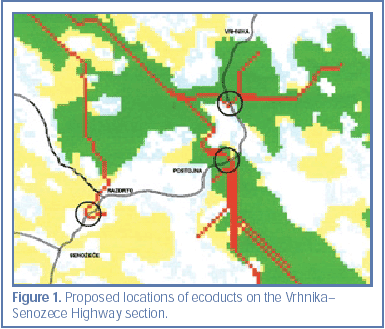  |
As part of the development of the European Handbook, there have been discussions of minimum standards for evaluation and monitoring of measures taken for wildlife, whether structural or nonstructural. Lack of standardized methods and study designs in the United States and Europe limits comparability of data and information obtained as to the effectiveness of a measure. As in the United States, the Europeans also discuss what constitutes an "effective" measure. Is reduced mortality on the highway success? Is the measure connectivity at the population level? For what species? Land-management goals in the area play a role in what is considered effective. European countries are looking at the large landscapes in planning for effectiveness and providing crossing structures that accommodate most species in the landscape, from insects to large carnivores. France requires monitoring upon completion of a structure.
The monitoring period is for 1 year, with a revisit after 5 years to determine any necessary changes. Germany also requires monitoring for new structures. All countries visited have monitored the effectiveness of some structures with some good results, but this activity is not standardized in design or duration. Some of the study results are discussed in chapter 5. No new methods for monitoring wildlife passages are being used in Europe. Sand and ink beds are being used by most of the countries to monitor wildlife movement through structures of various sizes. Sand beds have proved to be a cost-effective method for documenting wildlife movement. Ink beds are largely used for tracking smaller animals. To a lesser extent, electronic counters (transponders) are used to record animal movement through crossings, sometimes in conjunction with sand or ink beds. The use of infrared still cameras to record animal movement through structures was observed in all of the
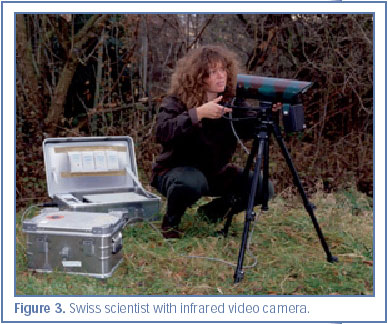 countries.
Figure 2 shows the camera setup on a Slovenian bridge. The use
of infrared video cameras is more extensive than in the United
States, and figure 3 shows a Swiss researcher with an infrared
video camera setup. The video cameras are used to observe the
behavior of animals using overpasses.
countries.
Figure 2 shows the camera setup on a Slovenian bridge. The use
of infrared video cameras is more extensive than in the United
States, and figure 3 shows a Swiss researcher with an infrared
video camera setup. The video cameras are used to observe the
behavior of animals using overpasses.
Similar to the United States, European scientists also are using radio telemetry equipment to document animal movement in habitat and connectivity studies. The results of studies using these techniques also are discussed in chapter 5.
The COST 341 report, Habitat Fragmentation contains a discussion of models to predict report identifies three categories of system models.
Dispersion models are usually individual movement and dispersal over either quality of the model depends on the modeled. The models can be used to look modeled to identify barriers and evaluate POLYWALK, and SmallStep are some Meta-population models are numerical, population dynamics (birth, death, habitat features (quality, size, and explicit, as regards habitats. The results evaluate landscape suitability for model are METAPHOR, RAMAS, and
Expert systems are models that use network populations to compare different decisionmaking in considering project GREINS, LEDESS, and LARCH.
The team was given a presentation of decisionmaking process. The Netherlands actively developing and using models
In the countries visited, mitigation and compensation for potential impacts to ecological systems are anticipated as part of the planning and project-development processes. Mitigation is perceived as the reduction of impacts by using structures or strategies when planning and developing infrastructure. Compensation, on the other hand, has implications in the international European Council (EC) Directives on Habitat and Species. Conceptually, compensation that replaces the same ecological values is mandatory under these directives. Since all countries visited have implemented the EC Directives for an EIA procedure that requires assessment of environmental impact analysis during the alternative routing phase (prior to decisionmaking), compensation requirements apply. Member country laws governing spatial development planning also include consideration of the EC Directive imperatives.
Nonstructural approaches to changing motorist or animal behavior would be the preferred and, often, most cost-effective means of reducing wildlife mortality and, perhaps, improving connectivity across transportation corridors. A number of these techniques were reported in the draft Europe State of the Art Report.
Some initial work has been done in Europe to look at olfactory foam repellents that contain mixed scents (human, predator, other unpleasant odors) to raise animal awareness or keep them away from roads. The foam is sprayed on trees or other structures along the road. Limited research indicates some promise in this area, although further research is needed. There is also an extensive maintenance requirement associated with this approach that could be expensive-keeping fresh scent out there.
Ultrasound is another approach that has been tried in Europe. There was no evidence of mortality reduction for those instruments that were researched.
Road lighting was looked at in relation to wildlife mortality, with the conclusion that it is not effective for reducing wildlife mortality. In fact, highway lighting may have negative impacts on nesting birds in the Netherlands (Molenaar et al., 2000). A reduction in habitat quality for nesting, which could extend several hundred meters from the road, was evidenced.
Population control through habitat management and hunting is another approach being tried in Europe. While this approach may be locally successful for reducing wildlife mortality, it does not address the larger issues of ecological quality and connectivity.
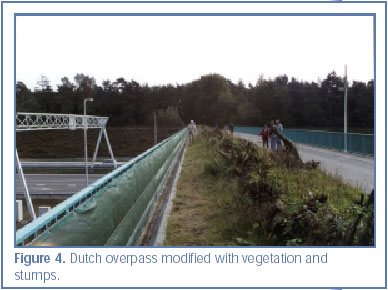 Habitat
Modification
Habitat
Modification Adaptation of habitat is another practice technique is used principally along the or to increase driver and animal visibility the road to reduce collisions of vehicles carefully selected to make the roadsides observed the planting of desirable species crossing structures. This type of habitat for a wide variety of animals, including intentional planting of a continuous for these species.
Stumps and other structures (rocks, organisms, when placed with wildlife structures. Rows of stumps are a common feature on Dutch overpasses and underpasses (figure 4).
On a larger scale, total landscape planning that includes structures for human and wildlife connectivity is being carried out in Europe. The team visited several sites where this technique is being used. In Switzerland, habitat corridors have been planted along Highway A1 to provide cover for animals using culverts under the highway. The Swiss also are planting habitat adjacent to overpasses to provide cover for wildlife approaching large overpasses on Highway N4.
The Germans are implementing large-transportation project as the catalyst wildlife and humans. The team visited accommodate both wildlife movement another rural area, near Lake Konstanz, along the lake has been preserved and connectivity has been constructed. ecological qualities of the area are
 STRUCTURAL
APPROACHES
STRUCTURAL
APPROACHESFence Applications Fences are used extensively in Europe to keep wildlife off of the major highways. The team observed a variety of fence types. A fine mesh wire (2 x 2 to 4 x 4 cm) is often seen on the bottom one-third to one-half of the fence to prevent both small and large animals from accessing the highway right-of-way. A fence height from 2.6 to 2.8 m is used for ungulates such as red deer, roe deer, and moose. This height needs to be maintained through terrain features and above winter snow levels. The fence is installed on the outside of the poles so that larger animals do not push it away from the poles. Smaller mesh fence should be buried from 20 to 40 cm underground to prevent small animals from digging under the fence. Figure 7 shows a number of fence types included on European projects. Exits from the inside of the fence include one-way gates or, preferably, earthen ramps that allow the wildlife to get over the fence (figure 8, page 16) if trapped in the rightof- way.
 Reflectors
Reflectors
Reflectors that beam light from headlights into adjacent habitats have been well researched in Europe. Molenaar and Henkens (1998) conducted a literature review of research on this type of structural alternative and concluded that there was no evidence that the reflectors worked or didn't work. The COST 341 report also concludes that these devices are ineffective.
Countries visited reported that standard wildlife signing has proved ineffective in Europe, because drivers become accustomed to them. The European countries are now using combination approaches. Combining wildlife signs with speed limit signs seems to increase their effectiveness. Including flashing lights also is believed to increase the effectiveness. The Swiss are using a series of solar-powered heat sensors to
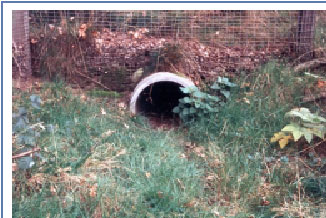 |
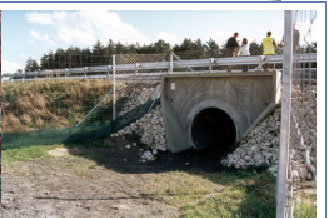 |
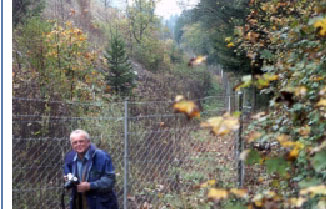 |
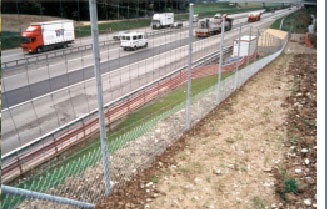 |
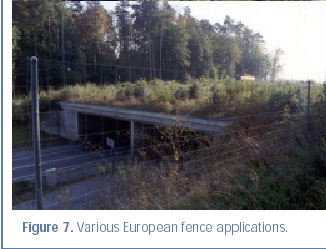 |
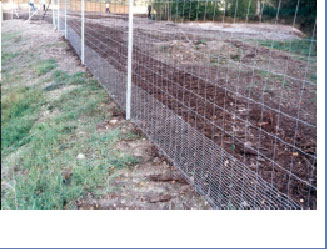 |
determine animal presence, which then triggers a fiberoptic wildlife warning sign to reduce speed to 40 km/h (figure 9, page 16). This installation has significantly reduced wildlife mortality on a two-lane regional road (Kistler, 1998).
The COST 341 effort reports that, although noise barriers are
typically constructed to reduce noise to human dwellings, noise
barriers for wildlife have been used in Europe
principally for colonies of nesting birds. Because the noise
barriers are solid
|
Amphibian and Other Small-Species CulvertsAmphibian culvert systems were observed in all countries, except Slovenia. Culverts are placed in known areas of amphibian movement to alleviate mortality on roadways. A number of approaches are used. It should be noted that these systems serve the movement of other small animals, as well as amphibians. Several types of barriers were observed for amphibians. Trenches are used to direct them to culvert structures under the roads. In Switzerland, a one-way system using a pipe for each direction was observed. A concrete trench is used to direct the amphibians to a drop inlet into the pipe leading to the other side. On the wetland side, pipes leading back to the other side are present (figure 10). Grossenbacher (1985) and Ryser (1988) reported that this system was more effective than just single pipes in which the amphibians could move in either direction. A metal rail type system was observed in Germany to direct reptiles and amphibians to wildlife culverts under Highway B30. In France, a fine mesh plastic material similar to silt screen is used at the bottom of fences to direct smaller animals, including amphibians, to culverts and overpasses. France also was using concrete walls to keep amphibians out of harm's way, but has since stopped using this expensive application.
. |
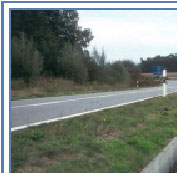 |
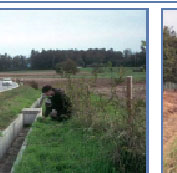 |
 |
 |
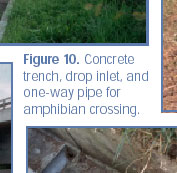 |
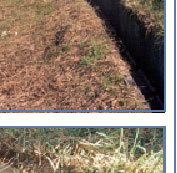 |
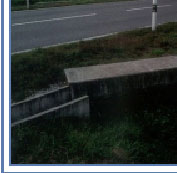 |
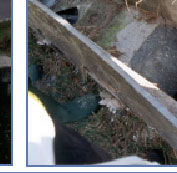 |
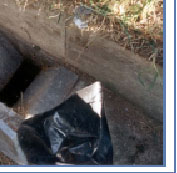 |
The Europeans also are modifying curbs and drains to prevent entrapment of reptiles and amphibians. In areas where amphibians are present in large numbers, ramps or breaks in the curb are provided, periodically, to allow exit from the roadway. Mesh screens are used over drainage inlets to keep the amphibians from becoming trapped in pipes.
Underpasses for other small species are similar in design to those used for amphibians. An accepted approach to providing habitat for smaller animals is the placement of rocks, stumps, and other debris in and around structures. In fact, this is becoming a common practice on larger structures, which are discussed next. Another approach used in Europe is providing plant cover around pipes or box culverts for smaller animals.
As might be expected, larger animals require larger structures. In fact, some species of larger mammals will only use very large underpasses or require overpasses or viaducts before they will move across highway corridors. This situation was observed for ungulates in research on structures in Slovenia. The dimensions for pipe and box
 |
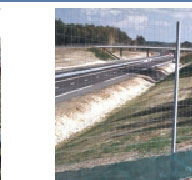 |
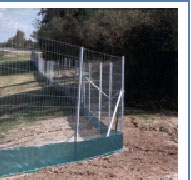 |
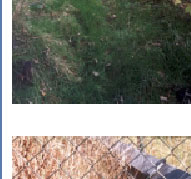 |
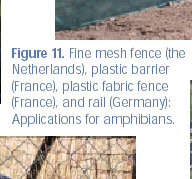 |
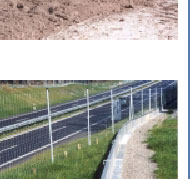 |
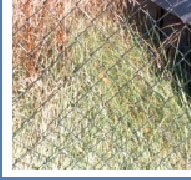 |
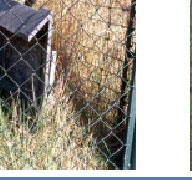 |
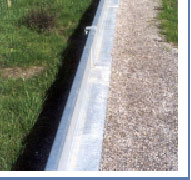 |
culvert underpasses vary greatly, depending on the wildlife being accommodated. For smaller mammals, widths of 5 to 12 m are common. Widths of 25 m or more are used for larger mammals; structures of these dimensions are typically box culverts or bridges over land.
Heights of structures vary, according to specific animal considerations. Generally, heights of 3 to 5 m have been successful. As mentioned earlier, structures such as stumps and piles of debris are often provided under larger crossing structures as cover for smaller animals.
The team visited a number of underpass structures for medium to large mammals. In France, the team visited an underpass on Highway 71 that was 3 m high and 6 m wide (figure 12). A private consultant is monitoring 9 passages with similar dimensions on this 15-year-old highway. Use of the crossing varies from year to year, and may be influenced by private land management adjacent to the crossing, as well as fluctuating wildlife populations in the area. The team also visited a wet culvert (3 m high x 6 m wide) that had been modified with a dry ledge to accommodate wildlife movement on Highway 71.
 On
A-87, which is 40 km north of Orleans, France, the team visited
a new four-lane, divided highway not open to traffic. The contractor,
Cofiroute, has used approximately 3.5-m pipe culverts for amphibians
and smaller animals (figure 13).
On
A-87, which is 40 km north of Orleans, France, the team visited
a new four-lane, divided highway not open to traffic. The contractor,
Cofiroute, has used approximately 3.5-m pipe culverts for amphibians
and smaller animals (figure 13).
In Germany, Highway B-30, another new route, has arch-pipe culverts for use by amphibians and small mammals (figure 14, next page). Fencing is designed to keep both small and large animals off of the highway and includes a rail system to guide amphibians to the crossings.
In Switzerland, pipe culverts for small animals are aligned with adjoining hedgerow habitat plantings on Highway A1. Pond habitat is included in the restored habitat area for amphibians and other wetland species. The hedgerow serves as a corridor of habitat that leads animals to the culverts.
The overpass is considered quite successful for the largest spectrum of animals. The presence of habitat and structure on overpasses allows
 French
pipe culvert for small mammals for use by everything from insects
amphibians. to large carnivores. European overpasses vary in
width from approximately 8 m to several hundred meters and are
often referred to as "landscape" or "green bridges."
French
pipe culvert for small mammals for use by everything from insects
amphibians. to large carnivores. European overpasses vary in
width from approximately 8 m to several hundred meters and are
often referred to as "landscape" or "green bridges."
The French often use an hourglass-shaped overpass design that is constricted in the area of the road in order to reduce structure cost. These overpasses usually have a width of 8 to 15 m at the narrowest point. On the tour of the A-87 project, the team observed four overpasses with the hourglass design (figure 15, next page). The narrowest point on these structures was 12 m, and 50 cm of soil was placed on the structures for vegetative growth. At one end of an overpass, there is a constructed pond for use by amphibians. Large boulders were placed at each end of the overpasses to prevent vehicular use. They also had high, wooden fences to serve as visual and noise barriers (figure 16, page 21). On this project, it was determined that having four

smaller overpasses would be more effective than fewer large overpasses. The French believe that habitat leading to and near the overpasses is important when using the smaller width crossings. The intent is not total connectivity but, rather, to facilitate enough crossing of animals to maintain genetic diversity of the separated animal populations.
 France
was the first European country to use overpasses. In 1991, France
had 125 overpasses in place and continues to use this as a principal
structure for connectivity and motorist safety. Some overpasses
are quite large, such as an 800-m-wide overpass at the Forest
Hardelot. Some overpasses serve dual purposes, where farm or
other roads share the tops of the overpass.
France
was the first European country to use overpasses. In 1991, France
had 125 overpasses in place and continues to use this as a principal
structure for connectivity and motorist safety. Some overpasses
are quite large, such as an 800-m-wide overpass at the Forest
Hardelot. Some overpasses serve dual purposes, where farm or
other roads share the tops of the overpass.
Germany has 32 overpasses, with 8 additional ones under construction and 20 more planned. Widths range from 8.5 to 870 m. As guidance for soil depth for plants on overpasses, the Germans use approximately 1/3 m for grass, 2/3 m for shrubs, and 1.5 to 2 m for trees. As in France, there are a number of dual-purpose crossings.
Overpasses are incorporated into landscape design in Germany, and
while also accommodating human particularly evident along the B-30 Highway, Konstanz conservation area via a number
widths from 3.4 m to 200 m, and are have additional, longer overpasses that corridors of habitat. Tunneling is done depending on site-specific newly constructed overpasses in along A-1, northeast of Bern, in the
 Central
Plateau, which were built in 1995. Figure 18 (page 22) shows
the Grauholz overpass (23 m wide). The overpasses cross six
lanes of traffic and have hedges, ponds, and clumps of bushes
(figure 19, page 22). They connect forested areas to serve as
connections mainly for roe deer and amphibians, along with other
wildlife.
Central
Plateau, which were built in 1995. Figure 18 (page 22) shows
the Grauholz overpass (23 m wide). The overpasses cross six
lanes of traffic and have hedges, ponds, and clumps of bushes
(figure 19, page 22). They connect forested areas to serve as
connections mainly for roe deer and amphibians, along with other
wildlife.
The team also visited a newly constructed Swiss overpass, on Highway N4, to accommodate a rail corridor in the Henggart/Rutibuck commune (figure 20, page 23). This was a large overpass, with a 50-m width over the road. The use of berms along the edge prevents traffic noise and lights from disturbing wildlife. A corridor of vegetation has been planted to provide habitat, through farmlands, to the crossing. Vegetation, debris piles, rock piles, and stumps are used on the overpass for small animal cover.
There are four overpasses in the Netherlands. The designs used are both hourglass and straight in configuration. The widths vary from 17 to 50 m, and each crosses a four-lane highway. One of the overpasses is extended to cross a farm road that runs alongside the four-lane highway.
There has been a good deal of research on the effectiveness of overpasses in Europe. Most researchers use tracks in sand, tracks in snow, counters, and infrared cameras to study crossing effectiveness. A more detailed account of the specific research is contained in the Swiss State of the Art Report, COST 341, Habitat Fragmentation Due to Transportation Infrastructure (European Commission Directorate General Transport, 2000). Briefly, Pfister et al. (1997) conducted research on five wildlife overpasses on the Stockach-Uberlingen section of German Highway B31 that the team visited. They also looked at 12 other overpasses in Germany, the Netherlands, France, and Switzerland. They did follow-up research on other overpasses (Pfister et al., 1999) using the same infrared video camera technology. The research looked at large mammals, small mammals, and flightless insects such as ground beetles,


grasshoppers, and ground spiders, along with diurnal butterflies. With suitable habitat on and around the overpasses, it was determined that the overpasses are very effective for a wide variety of animals. The conclusions included the observation that structures at least 60 m wide were more effective than overpasses narrower than 50 m, especially for larger mammals. It was noted that animal behavior on the overpasses is more normal on wider structures.
In a separate research project, Righetti et al. (1998) used infrared video technology to look at wildlife behavior on the Swiss overpass on A1 in Grauholz (the same one the team saw). They concluded that the alarmed behavior of roe deer, which is one of the target species, indicated that the crossing was too narrow (23 m). In a two-lane application, however, an overpass near Brienzwiler that is 17 m wide is used extensively and regularly by a wide variety of species-badger, fox, marten, chamois, roe deer, and red deer.
Other research on Swiss overpasses (Kaden et al., 1993) that examined two structures in Thurgau (127 m and 186 m, respectively) showed that they were valuable for mammals, ground spiders, ground
of the overpass, along with the were important factors. Overall, width, detailed design, and habitat for species in the area being studied. For but may not be necessary for specified. Along with viaducts, variety of species.

 Viaducts
Viaducts
As mentioned previously in the planning section, a viaduct was constructed in Slovenia to provide connectivity for a variety of wildlife, including the brown bear. There are three viaducts (593, 160, and 265 m long, respectively) on the Ljubljana- Trieste Highway. The highway cuts off a large area of habitat in western Slovenia from habitat in southern Slovenia. The team visited one of the viaducts (figure 21) in the Razdrto-Dolenja section of the highway that was successfully being used by the target species-brown bear, wolf, a number of ungulates, and some smaller mammals (Jerina, 2001).
The team also visited a viaduct at the Payerne exit on A1, in Switzerland (figure 22, next page). The Swiss use stumps under the viaduct as small animal cover. This practice was first successfully tried by the Dutch. Unfortunately, the effectiveness of this viaduct and the associated wildlife underpass may be compromised because of poor land-use planning in the adjacent area where habitat may be converted to commercial use.
Viaducts are extensively used in Europe, especially in areas with undulating terrain and over water bodies. As in the United States, bridge extensions can result in maintaining connectivity along riparian corridors. These structures can be of great length and, therefore, provide the opportunity for habitat/wildlife connectivity as well as human connectivity. They are commonly built for purposes other than wildlife connectivity but can also serve this purpose, if proper habitat connectivity is provided.
Slovenian researchers monitored 11 underpasses, 5 bridges, and 2 viaducts in studying the Ljubljana-Trieste Highway. The total research (Jerina, 2001) involved 7,300 days of monitoring over a 5-year period, making it one of the more extensive long-term research efforts reported in Europe. Many of the structures were built for

 human
connectivity but were being used by wildlife. Most species,
with the exception of ungulates, used the bridges. The frequency
of use of bridges was negatively impacted by increased traffic
on the bridges. The existing structures on the highway were
used by at least 14 different species of wildlife.
human
connectivity but were being used by wildlife. Most species,
with the exception of ungulates, used the bridges. The frequency
of use of bridges was negatively impacted by increased traffic
on the bridges. The existing structures on the highway were
used by at least 14 different species of wildlife.
Each country visited had multipurpose structures that accommodated wildlife and transportation needs. The Dutch have modified existing bridges by closing one lane and covering it with fill for vegetation, then including stumps and other structure for wildlife use. They also have taken existing drainage structures and built ledges or decks for use by small wildlife species (figure 23). Both of these approaches have proved successful for some wildlife movement.
The role of maintenance forces in the success of European techniques for accommodating wildlife is considerable. In the Netherlands, maintenance funds and forces are extensively involved in carrying out the program for badger crossings and existing structure modifications for wildlife. In each country, fence maintenance is demanding, because fences are one of the principal measures for keeping wildlife off of the road. The additional bridges, underpasses, overpasses, and culverts require maintenance, if they are to remain effective. Some structures, such as amphibian trenches, fences, and culverts, also require special maintenance attention.
 In
all of the European countries visited, the highway right-of-way
was fenced to keep wildlife out, such that vegetation along
the roads was not considered wildlife habitat. In one area of
Switzerland, fences were placed near the road so that the right-of-way
outside the fence could be left as habitat.
In
all of the European countries visited, the highway right-of-way
was fenced to keep wildlife out, such that vegetation along
the roads was not considered wildlife habitat. In one area of
Switzerland, fences were placed near the road so that the right-of-way
outside the fence could be left as habitat.
The habitat on overpasses is maintained for native wildlife species, and active seeding and planting of these species was evident. The plants were placed for food and cover. On larger overpasses, infrared video and browse evidence indicated that animals were
CHAPTER 5: MITIGATION AND COMPENSATION
actually feeding on the overpasses (Pfister et al., 1997, 1999; Righetti et al., 1998). This finding was in contrast to the alarmed behavior and rapid movement of animals on the narrower overpasses.
A key factor in the success of all wildlife-connectivity structures is maintenance of adjacent habitat to facilitate wildlife movement to the structures. The team learned of agreements with landowners and associations to provide for the maintenance of adjacent habitats. In Switzerland, the government provides financial compensation for landowners if they leave at least 10 percent of their land in native habitat. Along with land-use planning, these factors have contributed to providing connecting habitat.
The condition of the roads and structures for wildlife indicates that maintenance forces are being adequately funded to take care of these features. This need for maintenance is an important consideration in budgeting for wildlife considerations in transportation programs. Maintenance is a mix of public and private activity in the European countries.
The Wildlife Habitat Connectivity and Highways Scan Team developed the following conclusions and recommendations for application in the United States:
Strong policy and regulatory guidance are leading efforts in Europe. Several European countries provide funding for retrofit of structures for wildlife. One approach taken in Europe is to include these funds in the maintenance budget to be implemented as maintenance activities.
A stronger policy for "avoidance" of impacts to wildlife and habitats exists in Europe than in the United States. The scan team sees a need for greater attention to avoidance, when demonstrating the current "avoidance and minimization" requirements of the FHWA's NEPA process. This effort could be accomplished by a stronger consideration of avoidance alternatives in transportation planning and implementation.
Because of significant habitat losses in the past, some of the European countries compensate for habitat loss, irrespective of habitat type. The scan team concluded that at least two principles of European policy could be implemented in the United States: 1) an ecological, rather than species-specific, perspective for compensation, and 2) the principle of compatible land-use management, in areas of highway structures built for wildlife passage. European countries also make a strong effort to involve private lands in plans for the use of adjacent land. The role of private lands adjacent to highways is an area that needs further policy development in the United States.
The scan team identified the following specific policy improvements that would be helpful in the United States:
CONCLUSIONS AND RECOMMENDATIONS
The agencies identified for implementation of policy elements were the FHWA, State transportation agencies, the U.S. Forest Service, the Fish and Wildlife Service, the Environmental Protection Agency, and the Bureau of Land Management.
One of the strong points of the European effort is the communications network that has been developed to coordinate information, enhance wildlife connectivity, and garner support for providing measures for wildlife in the transportation system. The Europeans have used many symposia and journals to spread information related to wildlife and transportation.
The scan team identified the following specific communication strategies that would be helpful in the United States:
CONCLUSIONS AND RECOMMENDATIONS
Many of the countries visited have been developing guidance documents that will greatly facilitate additional measures for wildlife within the transportation systems. Strong interagency and other external coordination was evident in several countries, and similar efforts should be initiated in the United States. The Europeans seem to have common definitions for terminology that is typically used to address wildlife issues, which is not the case in the United States. Specific guidance on structure types, sizes, and designs have been developed in several European countries, and several countries have specific requirements for postconstruction monitoring using successful methods, such as infrared cameras, for monitoring structure use by animals.
The scan team believes that the following guidance packages would be helpful in the United States:
CONCLUSIONS AND RECOMMENDATIONS
Several of the countries that the team visited had strong research programs to support decisions on wildlife measures. While this effort has begun in the United States, several areas should be emphasized. One distinctive element of the European measures to provide wildlife connectivity is the consideration of all types of animals in the design of structures.
The scan team recommends the following research efforts in the United States:
IMPLEMENTATION PLAN
Three projects are currently under development (Vermont DOT: Dry Bridge; Montana DOT: Green Bridge; and California DOT in partnership with the National Park Service: Green Bridge). These bridges are all results of the scan tour. Monitoring will be done at all locations to determine the impact of the roadway on wildlife movements.
For an evaluation of the safety benefits of wildlife passages, volunteer pilot States should be sought that have roadways experiencing a large number of animal/vehicle collisions. Wildlife passages should be constructed on segments of the roadway, as hazard elimination projects, to evaluate the effectiveness of these structures in reducing collisions.
Preliminary list
IMPLEMENTATION PLAN
European Commission, Directorate General Transport. 2000. COST 341, Habitat Fragmentation Due to Transportation Infrastructure, Swiss State of the Art Report. Luxembourg: Office for Official Publications of the European Communities. 515 pp.
Grossenbacker, K. 1985. Amphibien und Verkehr, Teil 1. KARCH, Bernastr. 15, 3005 Bern, Switzerland. 22 pp.
Jerina, K. 2001. Influences of the Highway on the Big Mammalia. In Mitigation of Transportation Corridor Effects on Large Carnivore Populations in Slovenia.
Workshop for the Wildlife Mortality Study Tour of the Federal Highway Administration. Ljubljana, Slovenia, October 7, 2001.
Kistler, R. 1998. Wissenschaftliche Begleitung der Wildwarnanlagen Calstrom WWA-12-S: Juli 1995 - November 1997, Schlussbericht. Infodienst Wildbiologie & Oekologie. Strickhofstrassee 39, 8057, Zurich, Switzerland.
Kaden, D., C. Meienberger, and P. Beerli. 1993. Erfolgskontrolle der okologischen Massnahment an der Neubaustrecke der N7. Bericht im Auftrag des Tiefbauamtes des Kantons Thurgau. Buro fur Okologie und EDV, Frauenfeld, Switzerland. 48 pp.
Kobler, A., and M. Adamic. 1999. "Brown Bears in Slovenia: Identifying Locations for Construction of Wildlife Bridges across Highways." In G. L. Evink, P. Garrett, and D. Zeigler, Proceedings of the Third International Conference on Wildlife Ecology and Transportation. FL-ER-73-99. Florida Department of Transportation, Tallahassee, Florida.
Molenaar, J.G. de, and R.J.H.G. Henkens. 1998. Effectiviteit van wildspiegels: een literatuurevaluatie. Instituut voor Bos-en Natuuronderzoek, Wageningen, The Netherlands. 106 pp.
Molenaar, J.G. de, D.A. Jonkers, and M.E. Sanders. 2000. "Road Illumination and Nature III. Local Influence of Road Lights on a Black-tailed Godwit (Limosa l. limosa) Population." Alterra and Ministry of Transport, Public Works and Water Management, The Netherlands. DWW Report No. P-DWW-2000-058. 88 pp.
Pfister, H.P., V. Keller, H. Reck, and B. Georgii. 1997. Bio-okologische Wirksamkeit von Grunbrucken uber Verkehrswege. Forschung, Strassenbau und Strassenverkerhrstechnik, 756. Bundesministerium fur Verkehr (Ed.), Bonn, Switzerland. 590 pp.
Pfister, H.P., D. Heynen, B. Georgii, V. Keller, and F. von Lerber. 1999. Haufigkeit und Verhalten ausgewahlter Wildsauger auf unterschiedlich breiten Wildtierbrucken (Grunbrucken). Schweizerische Vogelwarte, Sempach, Switzerland. 49 pp.
Ryser, J. 1988. Amphibien und Verkehr, Teil 2: Amphibienrettungsmassnahmen an Strassen in der Schweiz - gegnwartiger Stand, Erfahrungen und Bedeutung fur den Artenschutz. KARCH, Bernastr. 15, 3005 Bern, Switzerland. 10 pp.
UNA (Righetti et al.). 1998. A8 - Umfahrung Breinzwiler/Bericht zur Erfolgskontrolle der Wildtieruberfuhrung (Objekt B86 und des Bachdurchlasses (Objekt B84). Im Auftrag des Tiefbauamtes des Kantons Bern. UNA, Atelier fur Naturschutz und Umweltfragen, Muhlenplatz 3, 3011 Bern, Switzerland.
SLOVENIA
Miha Adamic, Ph.D.
Associate Professor of Wildlife Ecology
University of Ljubljana
Department of Forestry and Renewable
Forest Resources
Venca pot 83
1111 Ljubljana, Slovenia
Tel: (+386 61) 123-11-61
Fax: (+386 61) 271-169
Email: miha.adamic@uni-lj-si
Klemen Jerina
University of Ljubljana
Department of Forestry and Renewable
Forest Resources
Venca pot 83
1111 Ljubljana, Slovenia
Tel: +386 (0) 4231161
Fax: +386 (0) 1 2571169
Email: klemenjerina@hotmail.com
Andrej Kobler, M.Sc.
Researcher
Slovenia Forestry Institute
Department of Forest Inventory and
Spatial Information
Vecna pot 2
Sl-1000 Ljubljana, Slovenia
Tel: +386 (0) 1 2007835
Fax: +386 (0) 1 2573589
Email: Andrej.kobler@gozdis.si
Alenka Korenjak, M.Sc.
Agrictultural Land and Forest Fund
Dunajska 58
Sl-1000 Ljubljana, Slovenia
Tel: +386 (0) 4341103
Niko Torelli, Director
Slovenia Forestry Institute
Vecna pot 2
1000 Ljubljana, Slovenia
Tel: 01 200 78 01
Fax: 01 257 35 89
Email: niko.torelli@gozdis.si
SWITZERLAND
Niklaus Gysel
Baudirekton Kanton Zurich
Forstpflanzgarten Finsterloo
8185 Winkel, Switzerland
Tel: 01 863 71 63/61
Fax: 01 863 71 64
Email: niklaus.gysel@bd.zh.ch
Daniela Heynen
Projekteiterin "Grundlagen fur die
Praxis"
Swiss Ornithological Institute
CH-6204 Sempach, Switzerland
Tel: 041 462 97 00
Fax: 041 462 97 10
Email: Daneila.heynen@vogelwarte.ch
Otto Holzgang, Ph.D.
Stv. Leiter "Grundlagen fur die Praxis"
Swiss Ornithological Institute
CH-6204 Sempach, Switzerland
Tel: 041 462 97 00
Fax: 041 462 97 10
Email: otto.holzgang@vogelwarte.ch
Verena Keller, Ph.D.
Stv. Leiterin "Uberwachung Avifauna"
Swiss Ornithological Institute
CH-6204 Sempach, Switzerland
Tel: 041 462 97 00
Fax: 041 462 97 10
Email: verena.keller@vogelwarte.ch
Alain R. Maibach, Ph.D.
Biologiste
AMAibach
Bureau d'etudes en environnement
Rte de Moudon 11
CH-1610 Oron-la-Ville, Switzerland
Tel: 0041 21/907 15 15
Fax: 0041 21/907 15 16
Email: a.maibach@bluewin.ch
Antonio Righetti
Partner in Umweltfragen
Gurtenbrauerei, Postfach 240
3084 Wabern, Switzerland
Tel: 031 960 43 26
Fax: 031 960 43 27
Email: a.righetti@bluewin.ch
Marguerite Trocme
BUWAL
Abt. Landschaft
3003 Bern, Switzerland
Tel: 031 322 80 03
Email: marguerite.trocme@buwal.admin.ch
Peter S. Weiller
Ferstingenieur ETH/SIA
Buro fur Wald, Landschaft und Natur
Gemeindehaus
8465 Rudolfingen, Switzerland
Tel: 052 319 15 00
Fax: 052 319 30 90
Email: weiller@bluewin.ch
Marita Bottcher
Fachgelbiet Eingriffsregelung
Bundesamt fuer Naturschutz
Karl-Liebknecht-Str. 143
D-04277 Leipzig, Germany
Tel: 03 41 3 09 77 21
Fax: 03 41 3 09 77 40
Email: boettcherm@bfn.de
Karin Chluba
Referatsleiterin
Landschaftspflege, Umweltschutz
Stuttgarter Strasse 161
70 806 Kornwestheim, Germany
Tel: 07154 139 312
Fax: 07154 139499
Email: Karin.chluba@lfl.bwl.de
Walter Decker
Oberbaurat
Strassenbauamt Ueberlingen
Bahnhofstrasse 5
88 662 Ueberlingen, Germany
Tel: 07551/835-136
Fax: 07551/835-111
Email: decker@GT04.SBAUE.SBV.bwl.de
Matthias J. Herbert
Abteilungsleiter Landschaftsplanung und
gestaltung
Bundesamt fur Naturschutz
Aussenstelle Leipzig
Karl-Liebknecht-Str. 143
D-04277 Leipzig, Germany
Tel: 49 (0) 341 3 09 77 11
Fax: 49 (0) 341 3 09 77 40
Email: HerbertM@bfn.de
Heinz-Deiter Muss
Regierungsdirektor
Bunderministerium fuer Umwelt,
Naturschutz und Reaktorsicherheit
Referat N I 4
Postfach 12 06 29
53048 Bonn, Germany
Tel: 02 28 3 05 26 41
Fax: 02 28 3 05 26 96
Email: Muss.Heinz@BMU.de
Heinrich Reck
Fachabteilung fur Landschaftsokologie
Christian-Albechts - Universitat Zu Kiel
Okologie-Zentrum
Schauenburgerstr. 112
D-24118 Kiel, Germany
Tel: 0431/880-4538
Fax: 0431/880-4083
Email: h.reck@pz-oekosys.uni-kiel.de
APPENDIX A
Wolgang Schettler
Fachbereich Landschftsplanung
Eberhard + Partner
Glarnischstrasse 8
78464 Konstanz,
Germany
Tel: 07531/812915
Fax: 07531/812911
Email: Eberhard-Partner-Konstanz@t-online.de
Albrecht Schlierer
Umwelt-und Naturschutz im Strassenwesen
Ministerium fur Umwelt und Verkehr
Baden-Wuerttemberg Huaptstatter Strasse 67
70178 Stutgart,
Germany
Tel: 07 11 126 16 32
Fax: 07 11 126 10 99
Email: Albrecht.schlierer@uvm.bwl.de
Udo Tegethof, Ph.D.
Bundesanstalt fuer Strassenwesen Oberregierungstrat Bruederstrasse
53 51427 Bergisch Gladbach Postfach 10 01 50
51401 Bergisch Gladbach,
Germany
Tel: 0 22 04/43-562
Fax: 0 22 04/43-673
Albert Bourrel
Delegue aux relations exterieures
Service d'Etudes Techniques des Routes et Autoroutes
46, avenue Aristide Briand-
BP 100-
92223 Bagneux
Cedex, France
Tel: 01 46 11 33 84
Fax: 01 46 11 36 50
Jean Carsignol
Ingenieur Ecologue
Directeur d'Etudes Division Environnement
1, boulevard Solidarite
- Technopole METZ 2000 B.P. 85230 -
57076 Metz
Cedex 03, France
Tel: 03 87 20 46 14
Fax: 03 87 20 46 49
Email: Jean.Carsignol@equipement.gouv.fr
Guy Desire
Groupe Environnement
Centre d'Etudes Techniques de l'Equipement de l'Ouest
M.A.N.
- Rue Rene Viviani -
BP46223
44262 Mantes Cedex 2,
France
Tel: 02 40 12 83 53
Fax: 02 40 12 84 44
Email: guy.desire@equipement.gouv.fr
Michel Galet
Charge d'Etudes Cofiroute
Direction des Projets et de la Construction
"La Vente aux Moines"
45770 Saran, France
Tel: 02 38 79 11 54
Fax: 02 38 79 11 68
Jocelyne Le Boudec
International Activities
Service d'Etudes
Techniques des Routes et Autoroutes
46, avenue Aristide
Briand-BP-100
92225 Bagneus Cedex,
France
Email: leboudec@setra.fr
G.J. (Hans) Bekker
Programme-manager Defragmentation Infrastructure, Environmental
Affairs
Ministry of Transport, Public Works and Water Management
Van der Burghweg 1
P.O. Box 5044
2600 GA Delft, The Netherlands
Tel: +31 15 251 83 80
Fax: + 31 15 251 85 55
Email: g.j.bekker@dww.rws.minvenw.nl
Rob Bugter
ALTERRA
P.O. Box 47
6700 AA Wageningen, The Netherlands
Tel: (011-31) 317-477-954
Email: R.J.F. Bugter@ALTERRA.WAG-UR.NL
Tatiana Damarad
European Centre for Nature Conservation
Ministry of Transport, Public Works and Water Management
Van der Burghweg 1
P.O. Box 5044
2600 GA Delft, The Netherlands
Tel: (011-31) 13-466-3240
Fax: (011-31) 13-466-3250
Email: DAMARAD@ECNC.NL
Marcel Huijser
Research Institute for Animal Husbandry
Postbus 2176 NL-8203 AD
Lelystad, The Netherlands
Tel: +31 -(0) 320-293455
Fax: +31 -(0) 320-241584
Email: M.P.Huijser@pv.agro.nl
APPENDIX A
Beno Koolstra
ALTERRA
P.O. Box 47
6700 AA Wageningen, The Netherlands
Tel: +31 317 47 79 66
Fax: +31 317 42 49 88
Email: B.J.H.Koolstra@ALTERRA.WAG-UR.NL
Hans Molenaar
ALTERRA
P.O. Box 47
6700 AA Wageningen, The Netherlands
Tel: (011-31) 317-477-731
Email: J.G.Demolenaar@ALTERRA.WAG-UR-NL
Robbert Snep
ALTERRA
P.O. Box 47
6700 AA, Wageningen
Tel: +31 317 47 79 46
Fax: +31 317 42 49 88
Email: R.Snep@alterra.wag-us.nl
Govert Sweere
Programme Manager Europe
Ministry of Transport,
Public Works and Water Management
Van der Burghweg 1
P.O. Box 5044
2600 GA Delft, The Netherlands
Tel: +31 15 251 83 80
Fax: +31 15 251 85 55
Email: g.t.h.sweere@dww.rws.minvenw.nl
Edgar van der Grift
ALTERRA
P.O. Box 47
6700 AA Wageningen,
The Netherlands
Tel: (011-31) 317 47 79 48
Fax: (011-31) 317 42 49 88
Email: E.A.Vandergrift@ALTERRA.WAG-UR.NL
APPENDIX A
Michiel van Eupen
ALTERRA
P.O. Box 47
6700 AA, Wageningen,
The Netherlands
Tel: +31 317 47 43 89
Fax: +31 317 419000
Geesje Veenbaas
Senior Landscape-Ecologist
Infrastructure and Environmental Affairs
Ministry of Transport, Public Works and Water Management
Van der Burghweg 1
P.O. Box 5044
2600 GA Delft,
The Netherlands
Tel: +31 (15) 251 84 82
Fax: +31 (15) 251 85 55
Email: g.veenbaas@dww.rws.minvenw.nl
Fred G. Bank (FHWA Co-leader)
Ecologist-Team Leader
Federal Highway Administration
HEPN-30, Room 3240
400 7th Street S.W.
Washington, D.C. 20590
Tel: (202) 366-5004
Fax: (202) 366-3409
Email: fred.bank@fhwa.dot.gov
C. Leroy Irwin (AASHTO Co-leader)
Manager, Environmental Management
Office
Florida Department of Transportation
605 Suwannee St., MS # 37
Tallahassee, FL 32399-0450
Tel: (850) 922-7201
Fax: (850) 922-7217
Email: Leroy.Irwin@dot.state.fl.us
Gary L. Evink, Ecologist (Report
Facilitator)
3700 Sally Lane, Suite 200
Tallahassee, FL 32312
Tel: (850) 668-9215
Fax: (850) 668-9215
Email: garyevink@aol.com
Mary E. Gray
Federal Highway Administration
Idaho Division
3050 Lake Harbor Lane, Suite 126
Boise, ID 83616
Tel: (208) 334-9180 x 123
Fax: (208) 334-1691
Email: mary.gray@fhwa.dot.gov
Susan Hagood
Wildlife Issues Specialist
The Humane Society of the United States
2100 L Street, N.W.
Washington, D.C. 20037
Tel: (301) 258-3149
Fax: (301) 258-3080
Email: shagood@hsus.org
John R. Kinar, P.E.
Chief of Winter Operations and Roadside
Management
Wisconsin Department of Transportation
4802 Sheboygan Ave., Box 7986
Madison, WI 53707-7986
Tel: (608) 266-1202
Fax: (608) 267-7856
Email: john.kinar@dot.state.wi.us
Alex Levy, Biologist
FHWA Southern Resource Center
61 Forsyth St., S.W.
Atlanta, GA 30303
Tel: (404) 562-3920
Fax: (404) 562-3700
Email: alex.levy@fhwa.dot.gov
Dale Paulson
Program Development Engineer
2880 Skyway Dr.
Helena, MT 59602
Tel: (406) 449-5302 x 239
Fax: (406) 449-5314
Email: dale.Paulson@fhwa.dot.gov
Bill Ruediger
Ecology Program Leader for Highways
USDA Forest Service
200 East Broadway
PO Box 7669
Missoula, MT 59807
Tel: (406) 329-3100
Fax: (406) 329-3171
Email: bruediger@fs.fed.us
Raymond M. Sauvajot, Ph.D.
Chief of Planning, Science and Resource
Management
U.S. National Park Service
Santa Monica Mountains National
Recreation Area
401 W. Hillcrest Drive
Thousand Oaks, CA 91360
Tel: (805) 370-2339
Fax: (805) 370-1850
Email: ray_sauvajot@nps.gov
Fred G. Bank (FHWA Co-leader) Ecologist-Team Leader Federal Highway Administration HEPN-30, Room 3240 400 7th Street S.W.
Washington, D.C. 20590 Tel: (202) 366-5004 Fax: (202) 366-3409 Email: fred.bank@fhwa.dot.gov
C. Leroy Irwin (AASHTO Co-leader) Manager, Environmental Management Office Florida Department of Transportation 605 Suwannee St., MS # 37 Tallahassee, FL 32399-0450 Tel: (850) 922-7201 Fax: (850) 922-7217 Email: Leroy.Irwin@dot.state.fl.us
Gary L. Evink, Ecologist (Report Facilitator) 3700 Sally Lane, Suite 200 Tallahassee, FL 32312 Tel: (850) 668-9215 Fax: (850) 668-9215 Email: garyevink@aol.com
Mary E. Gray
Federal Highway Administration Idaho Division 3050 Lake Harbor Lane, Suite 126 Boise, ID 83616 Tel: (208) 334-9180 x 123 Fax: (208) 334-1691 Email: mary.gray@fhwa.dot.gov
Susan Hagood
Wildlife Issues Specialist
The Humane Society of the United States 2100 L Street, N.W.
Washington, D.C. 20037 Tel: (301) 258-3149 Fax: (301) 258-3080 Email: shagood@hsus.org
John R. Kinar, P.E.
Chief of Winter Operations and Roadside Management Wisconsin Department of Transportation 4802 Sheboygan Ave., Box 7986 Madison, WI 53707-7986 Tel: (608) 266-1202 Fax: (608) 267-7856 Email: john.kinar@dot.state.wi.us
Alex Levy, Biologist
FHWA Southern Resource Center 61 Forsyth St., S.W.
Atlanta, GA 30303 Tel: (404) 562-3920 Fax: (404) 562-3700
Email: alex.levy@fhwa.dot.gov
Dale Paulson
Program Development Engineer 2880 Skyway Dr.
Helena, MT 59602 Tel: (406) 449-5302 x 239 Fax: (406) 449-5314
Email: dale.Paulson@fhwa.dot.gov
Bill Ruediger
Ecology Program Leader for Highways USDA Forest Service 200 East Broadway PO Box 7669 Missoula, MT 59807 Tel: (406) 329-3100 Fax: (406) 329-3171 Email: bruediger@fs.fed.us
Raymond M. Sauvajot, Ph.D.
Chief of Planning, Science and Resource Management U.S. National Park Service Santa Monica Mountains National Recreation Area 401 W. Hillcrest Drive Thousand Oaks, CA 91360 Tel: (805) 370-2339 Fax: (805) 370-1850 Email: ray_sauvajot@nps.gov
APPENDIX B
David J. Scott, P.E.
Director of Project Development
State of Vermont Agency of
Transportation
National Life Building - Drawer 33
Montpelier, VT 05633-5001
Tel: (802) 828-2663
Fax: (802) 828-2437
Email: david.scott@state.vt.us
Patricia White
Transportation Associate
Defenders of Wildlife
1101 Fourteenth Street, N.W.
Suite 1400
Washington, D.C. 20005-5606
Tel: (202) 772-0236
Fax: (202) 682-1331
Email: twhite@defenders.org
The following is a list of questions on the six areas that the U.S. panel would like to discuss with you. These questions are intended to clarify and expand on the Panel Topics of Interest described in the Panel Overview paper. In the questions, the use of the word wildlife applies to both terrestrial and aquatic animals, including vertebrates and invertebrates. Mitigation is the concept of compensation for impacts to wildlife or habitat.
The panel is very interested in being able to visit sites where some of the concepts discussed have been applied. If possible, the panel would like to be able to devote 50 percent or more of its time with you for site visits. Examples of successful and not so successful applications in the documentation process, environmental studies, research, and structural and nonstructural successes and failures are of interest to the panel to allow for a broader understanding of these topics.
Do you find that dead animals along the road attract carnivores that are then killed on the highway?
APPENDIX C
APPENDIX C
APPENDIX C
APPENDIX D: BIOGRAPHIC SKETCHES
Fred Bank (FHWA Co-Chair) is an Ecologist and Team Leader with the FHWA's Office of Natural Environment in Washington, D.C. Mr. Bank supervises a team of environmental scientists who develop agency policy, provide training, and manage research on a variety of environmental topics. The subject areas covered by his team include wildlife resources, wetlands, water quality, vegetation management, and hazardous materials, among others. Prior to his current position, Mr. Bank held several other environmental positions within FHWA's Office of Environmental Policy and Office of Research in Washington, D.C. His previous experience includes managing wildlife-related research and providing expert testimony on highway impacts to fish and wildlife habitat. Mr. Bank is a graduate of the University of California at Davis, holding both a Bachelor's and Master's degree in Range Management. He serves on several technical panels of the Transportation Research Board's (TRB) National Cooperative Highway Research Program.
C. Leroy Irwin (AASHTO Co-Chair) is the Manager of the Florida Department of Transportation (FDOT) Environmental Management Office in Tallahassee, Florida. Mr. Irwin currently directs the environmental management program for FDOT that includes environmental research and National Environmental Policy Act implementation, including ancillary laws such as the Federal Endangered Species Act. He has overseen the development of an extensive program of environmental research on wildlife mortality and mitigation over the past 30 years. He has also been directly involved in FDOT's wildlife mitigation programs, including wildlife crossings and other innovation mitigation concepts. He is currently overseeing an extensive program to streamline the environmental processes in Florida with the use of GIS to assess secondary impacts. Mr. Irwin is a graduate of the University of Florida, with a Bachelor of Science in Agriculture. He has received the AASHTO Alfred E. Johnson Achievement Award and the FHWA Environmental Excellence in Leadership Award.
Dr. William I. Boarman is a Research Wildlife Biologist with the United States Geological Survey in San Diego, California, and an adjunct Professor of Biology at the University of California, Riverside. Dr. Boarman conducts research on the ecology, conservation, and management of desert tortoises in the Mojave Desert of California. He also studies the ecology, behavior, and management of common ravens and their impact on tortoise populations. Dr. Boarman conducted an 8-year study investigating the effectiveness of a highway barrier fence and culverts beneath the highway in protecting desert tortoise and other vertebrate populations. He works closely with resource managers to ensure that the research is relevant to their needs and to help them implement recommendations leading from his and other scientists' work. Dr. Boarman received his Ph.D. from Rutgers University where he studied the evolution of avian song structure. He is a member of the Society for Conservation Biology, American Ornithologists' Union, and Herpetologists' League.
Gary Evink is an ecological consultant who recently retired after 31 years of public service to the State of Florida, including 25 years as the Ecologist for FDOT. His current areas of interest in the ecological area include wildlife ecology, stormwater quality, and wetland ecology. Mr. Evink is currently writing a synthesis study on
APPENDIX D
wildlife ecology and transportation for the TRB that will bring together research on the state of the practice in the United States. He has chaired two TRB Research Panels dealing with stormwater runoff and, currently, is the conference chairman for the series of International Conferences on Ecology and Transportation, which is about to hold its fourth conference in September. He has received the Al C. Church Award for excellence in the field of highway engineering and rendering distinguished service to FDOT and the FHWA Environmental Excellence Award for Environmental Leadership. Mr. Evink has a Master's degree in Ecology from the University of Florida.
Mary Gray is the Environmental/Right-of-way Program Manager for the State of Idaho. She is responsible for several program areas within Idaho: environment, right-of-way, scenic byways, enhancement projects, bicycle and pedestrian facilities, and recreational trails. She is responsible for ensuring that these programs are properly implemented according to program guidelines as well as all applicable laws and regulations. As part of her review and oversight during project development, she is actively involved in the development of mitigation for projects, which often includes analyzing whether some form of wildlife crossing is feasible. In addition, she is involved with the U.S. Forest Service in developing a wildlife crossing web page. She has a Master's in Civil Engineering from Stanford University as well as degrees in Environmental Studies and Geography from the University of California.
Susan Hagood is the Wildlife Issues Specialist for the Humane Society of the United States (HSUS). Her responsibilities include the "Give Wildlife a Brake!" campaign, migratory bird and selected State wildlife management issues, the federal predator control program, and the "Safe Cats" campaign-an effort to convince cat owners to keep their cats indoors for the safety of wildlife and their pets. Prior to joining the HSUS in 1991 she was with Defenders of Wildlife for 8 years. Ms. Hagood holds a B.A. from Stephens College in Columbia, Missouri, and has done graduate work in wildlife management at Louisiana State University. She is currently enrolled in a doctoral program at the University of Maryland in Marine, Estuarine, and Environmental Sciences.
John Kinar is the Chief of Winter Operations and Roadside Management in the Bureau of Highway Operations for the Wisconsin DOT. In the area of roadside management, Mr. Kinar is responsible for developing policies and procedures for the maintenance and operation of all roadside features, including vegetation management. He also is responsible for the development of a regional clearinghouse of information for the reduction of deer-vehicle crashes. Mr. Kinar has been with the Bureau of Highway Operations for 14 years and has been working on the deer/vehicle crash reduction effort for the past 2 years. He received his Bachelor of Science in Civil and Environmental Engineering from California State University at Long Beach in 1978. He is a licensed professional engineer in Wisconsin, is a member of the TRB Subcommittee on Reduction of Animal-Vehicle Crashes, and is a Friend on a number of other TRB committees with a focus on highway operations.
Alex Levy is an Ecologist for the FHWA's Southern Resource Center in Atlanta, Georgia. Mr. Levy currently provides expert assistance, training, and facilitation of
APPENDIX D
interagency coordination for a focus area including 13 southern U.S. States and the Caribbean territories. Mr. Levy is coordinating with FHWA bridge and hydraulics engineers to develop state-of-the-art training for State transportation engineers and environmental professionals to enhance habitat at stream crossings for improved fish passage and overall water quality. Prior to his present position, Mr. Levy served as a consultant to both public and private business performing environmental impact studies. Mr. Levy also serves on a standing committee that evaluates the potential for downlisting of several federally protected species found in association with highway studies. Mr. Levy holds a Bachelor's degree in Landscape Architecture from the University of Georgia and is a member of the Society of Wetland Scientists.
Dale Paulson is the Program Development Engineer for the FHWA's Montana Division Office. Mr. Paulson currently leads the program development team, which administers the federal-aid planning, environment, design, right-of-way, and research programs. His current emphasis is on context sensitive design (CSD), and he is directly involved with a project, using CSD concepts, that includes numerous wildlife crossings. Prior to his present position, he served as the Environmental Program Manager. Mr. Paulson is a graduate of Montana State University and holds a B.S. degree in Civil Engineering. He is a licensed professional engineer in North Dakota and serves on the Highway Division Environmental Quality Technical Committee of the American Society of Civil Engineers.
Bill Ruediger is the Ecology Program Leader for Highways and Roads for the U.S. Forest Service. Mr. Ruediger currently coordinates wildlife, fisheries, and hydrology issues with highways and roads affecting national forests throughout the United States. He is involved in a number of projects, including the development and implementation of wildlife and fish linkage areas; development of road and highway management practices that maintain and protect ecological processes at stream crossings; developing better communications between engineers and biologists relative to highway and road effects and mitigation for wildlife, fish, and watersheds; and cross training of biologists, hydrologists, engineers, and agency line officers in ecological problem solving for highways and roads. He has a Master's degree in Forest Management from the University of Idaho, a Bachelor's degree in Wildlife Management from Utah State University, and a degree in Animal Science from the University of New York. Mr. Ruediger's recent expertise is in addressing highway effects on large, wide-ranging carnivores, including grizzly bears, wolves, wolverines, fishers, and lynx. Mr. Ruediger has authored or co-authored a number of professional papers on the effects of highways on rare carnivores and on wildlife habitat linkages.
Dr. Ray Sauvajot is Chief of Planning, Science and Resource Management at the Santa Monica Mountains National Recreation Area and is a Science Advisor for the U.S. National Park Service. Dr. Sauvajot also holds adjunct faculty positions at the University of California, Los Angeles, and California State University, Northridge. Dr. Sauvajot's responsibilities include designing and supervising ecological projects to protect natural resources, managing science and research activities, overseeing cultural resources management programs, and supervising long-range and site-specific planning efforts in the Santa Monica Mountains, near Los Angeles, California. As a National Park Service Science Advisor, Dr. Sauvajot also provides consultation
APPENDIX D
assistance to other units of the National Park System. Dr. Sauvajot's research has focused on the effects of urban encroachment and habitat fragmentation on wildlife in southern California. He has conducted specific research on the effects of roads on wildlife and the utility of movement corridors for wildlife in fragmented landscapes. Dr. Sauvajot obtained a B.A. degree in Biology from the University of California, San Diego, and M.S. and Ph.D. degrees in Ecology from the University of California, Davis. Dr. Sauvajot is a member of the Ecological Society of America and the Society for Conservation Biology.
David J. Scott is the Director of Project Development for the Vermont Agency of Transportation. Mr. Scott oversees the design and construction of all highway projects in the State of Vermont. Vermont currently has projects both under design and under construction that include features to facilitate wildlife passage. Prior to his assignment as Director of Project Development, Mr. Scott worked in the Planning Division for VTrans, where his duties included developing GIS applications for mapping vehicle-animal collisions. Mr. Scott is a graduate of the University of Massachusetts, with a Bachelor's in Civil Engineering. He is a licensed professional engineer in Vermont and is involved with AASHTO and the Institute of Transportation Engineers.
Trisha White is the Transportation Associate for Defenders of Wildlife at its national headquarters in Washington, D.C. Ms. White directs the new Habitat & Highways campaign, which seeks to reduce the impact of surface transportation infrastructure on wildlife and encourages State and local authorities to incorporate wildlife conservation into transportation and community planning. Prior to her present position, Ms. White spent 3 years with World Resources Institute's Biological Resources program and 1 year as environment policy consultant to USAID's Global Environment Center. In 2000, she received her Master's degree in Environment and Resource Policy from George Washington University, and she has a Bachelor's degree in Political Science from Central Michigan University. Currently, Ms. White is on the planning committee for the International Conference on Ecology and Transportation (ICOET), and is spearheading efforts to more actively engage conservation professionals and activists in the upcoming transportation reauthorization debate.
Kathy Milani is a video production specialist with the Humane Society of the United States. She has produced many notable videos promoting a better understanding of the impacts of modern, human developments upon the habits and habitats of wildlife.